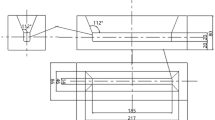Abstract
The deformation microstructure evolution of single crystal copper wires produced by OCC method has been studied with the help of TEM, EBSD and OM. The results show that there are a small number of dendrites and twins in the undeformed single crystal copper wires. However, it is difficult to observe these dendrites in deformed single crystal copper wires. The structure evolution of deformed single crystal copper wires during drawing process can be divided into three stages. When the true strain is lower than 0.94, macroscopic subdivision of grains is not evident, and the microscopic evolution of deformed structure is that the cells are formed and elongated in drawn direction. When the true strain is between 0.94 and 1.96, macroscopic subdivision of grains takes place, and the number of microbands located on {111} and cell blocks is much more than that with the true strain lower than 0.94. When the true strain is larger than 1.96, the macroscopic subdivision of grains becomes more evident than that with the true strain between 0.94 and 1.96, and S-bands structure and lamellar boundaries will be formed. From EBSD analysis, it is found that part of 〈100〉 texture resulting from solidifying is transformed into 〈111〉 and 〈112〉 due to shear deformation, but 〈100〉 texture component is still kept in majority. When the true strain is 0.94, the misorientation angle of dislocation boundaries resulting from deformation is lower than 14°. However, when the true strain arrives at 1.96, the misorientation angle of some boundaries will be greater than 50°, and the peak of misorientation angle distribution produced by texture evolution is located in the range between 25° and 30°.
Similar content being viewed by others
References
Ohno A. Continuous casting of single crystal ingots by O.C.C process. J Metals, 1986, 38(1): 14–19
Yan W, Chen J, Fan X H. Effects of grain boundaries on the electrical property of copper wires. Trans Nonferrous Met Soc China, 2003, 13(5): 1075–1079
Zhang H. Fundamental Research on Fabrication for Pure Copper Wires Containing Continuous Fibrous Crystals. PhD thesis (in Chinese). Beijing: Beijing University of Science and Technology, 2003
Xu Z M, Li J G, Li J S, et al. Mechanical properties and electrical resistivity of continuous casting single crystal copper. Trans Nonferrous Met Soc China (in Chinese), 1999, 9(3): 577–581
Li B L, Godfrey A, Meng Q C, et al. Microstructure of IF-steel during cold rolling. Acta Mater, 2004, 52: 1069–1081
Hansen N. Cold deformation microstructure. Mater Sci Tech, 1990, 6: 1039–1047
Kuhlmann-wilsdorf D. Theory of plastic deformation: Properties of low energy dislocation structure. Mater Sci Eng, 1989, A113: 1–41
Blicharski M, Dymek S, WrÓbel M. Inhomogeneities of microstructure evolved in metals under plastic deformation. J Mater Proc Tech, 1995, 53: 75–84
Hughes D A, Hansen N. Microstructure evolution in nickel during rolling from intermediate to large strains. Metall Trans A, 1993, 24: 2021–2037
Sakharova N A, Fernandes J V. Strain path change effect on dislocation microstructure of multicrystalline copper sheets. Mater Chem Phys, 2006, 98: 44–50
Waryobar D R. Deformation and annealing behavior of heavily drawn oxygen free high conductivity copper. PhD thesis. Florida: The Florida state University, 2003
Liu Q. A simple method for determining orientation and misorientation of the cubic crystal specimen. J Appl Cryst, 1994, 27: 755–761
Dymek S. Wróbel M. Polytypism in copper single crystals deformed at room temperature. Mater Chem Phys, 2003, 81: 552–554
Hughes D A, Hansen N, Bammann D J. Geometrically necessary boundaries, incidental dislocation boundaries and geometrically necessary dislocations. Scr Mater, 2003, 48: 147–153
Hughes D A, Hansen N. High angle boundaries formed by grain subdivision mechanisms. Acta Mater, 1997, 45(9): 3871–3886
Hughes D A, Chrzan D C, Liu Q, et al. Scaling of misorientation angle distributions. Phys Rev Lett, 1998, 81(21): 4664–4667
Author information
Authors and Affiliations
Corresponding author
Additional information
Supported by the National Natural Science Foundation of China (Grant Nos. 50471098 and 59971033), the Natural Science Foundation of Shaanxi Province, China (Grant No. 2003E101), and the Teaching and Research Award Program for Outstanding Young Teachers in Higher Education Institution of MOE, China
Rights and permissions
About this article
Cite this article
Chen, J., Yan, W., Wang, X. et al. Microstructure evolution of single crystal copper wires in cold drawing. Sci. China Ser. E-Technol. Sci. 50, 736–748 (2007). https://doi.org/10.1007/s11431-007-0029-x
Received:
Accepted:
Issue Date:
DOI: https://doi.org/10.1007/s11431-007-0029-x




